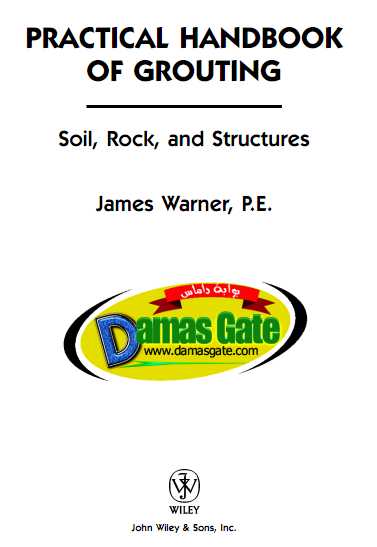Practical Handbook of Grouting Soil, Rock, and Structures

Preface
When I entered grouting in 1952, it was a generally undeveloped art with most
of the players professing magical powers. Work was performed on a somewhat
hit or miss basis with results that varied from excellent to complete failure. Little
equipment specifically built for grouting was available, and most work
was accomplished with simple water-cement suspensions, typically based on high
watercement ratios subject to large bleed, shrinkage, and poor durability.
Fortunately, that has all changed. Although we still have players that profess
magical powers, grouting has become well-established science, and work today
can be designed and performed according to sound engineering principles with
a good understanding of the processes that occur.
To cover all pertinent subject matter and facilitate its review, the handbook
is divided into three parts. Part I discusses the grouting process in a general way
and should be of interest to all readers. Here, the many conditions for which
grouting can be a solution are described, as are both grouting materials and
injection fundamentals. The five general types of grouting—permeation, compaction,
fracture, replacement, and fill—are discussed as is the pertinent methodology
for the main applications of
grouting, in rock, soil, and into concrete and
masonry structures. Separate chapters discuss specialized applications such as
Grout Jacking, Grouting in Pipes and Conduits, Leakage Control in Structures,
Grouting of Underground Structures, and Grouting in Extreme Environments.
Following a discussion of the very specialized but seldom used application of
Use of Explosives in Grouting, the section ends with a discussion of Emergency
Response Grouting.
Part II will be of particular interest to designers, engineers, and those responsible
for quality control, although the material presented should be useful to all
grouting participants. This part discusses the criteria upon which a grouting program
should be based. Design issues including required surface and subsurface investigation
are covered, as are monitoring and control of the actual work. Included
are the numerous activities that ensure proper performance, including chapters on
Understanding Geology, design and specification of grouting, quality control and
verification, and Numeric Analysis for Grouting. This part ends with discussion relative
to the preparation of contract documents, pay items, and The Games Contractors
Play, which must be considered when preparing those documents.
Download
http://s18.alxa.net/s18/srvs2/02/001...Structures.rar